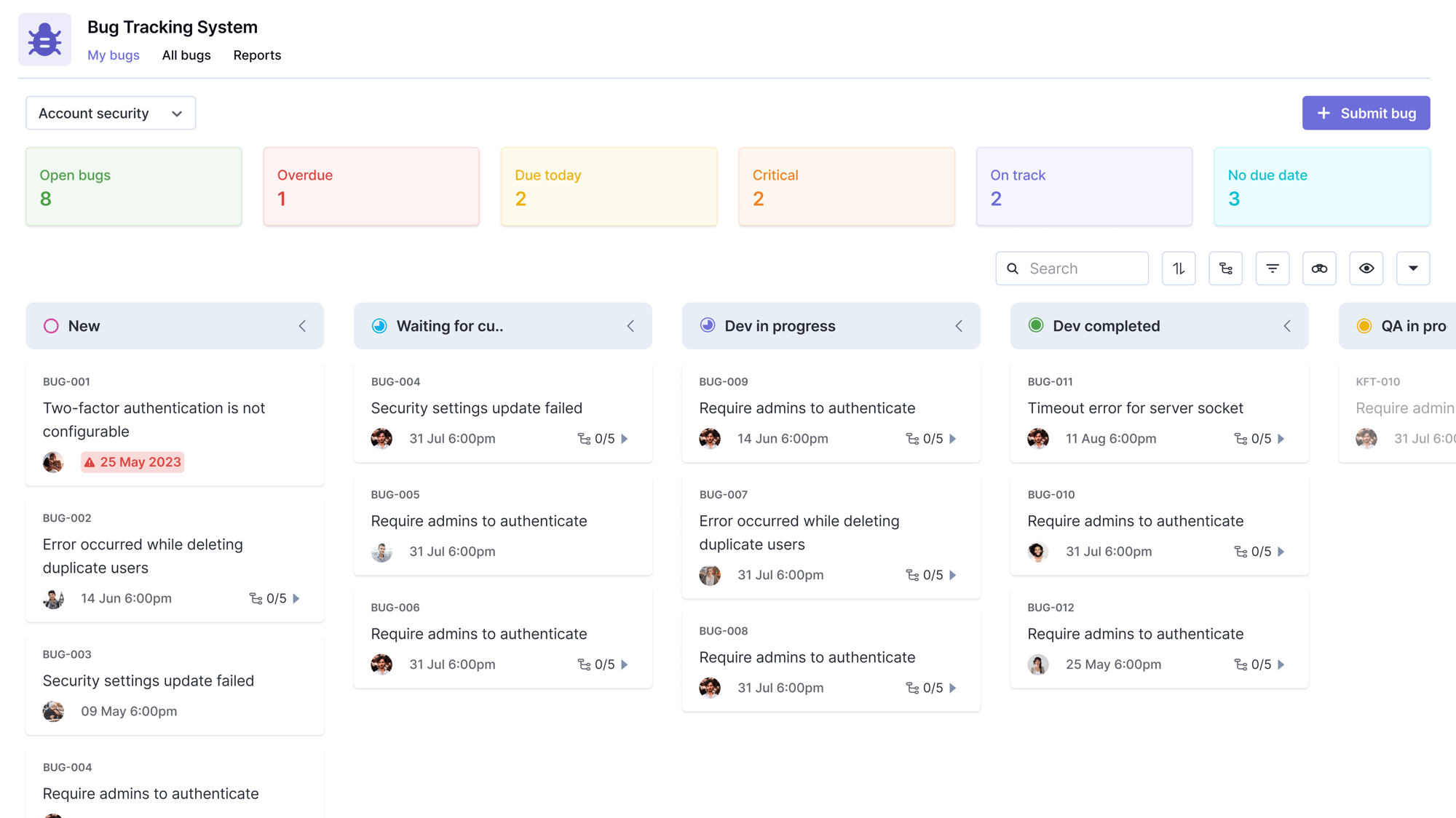As an essential part of strategic planning, project managers need to visually communicate the ambitions and key milestones of a project. That’s where project roadmaps come in handy. They help the stakeholders understand the projects’ goals, targets, allocated resources, and expected deliverables, all plotted out on a timeline.
The project plan gives an overview of the tactical details while the roadmap outlines the big picture, i.e., the most important components and milestones.
What is a project roadmap?
A project roadmap serves as a simple, easy-to-follow source of truth for key stakeholders to visualize the project from a strategic standpoint and make critical decisions without having to sift through the minutiae. Roadmap in project management offers a clearly defined breakdown of,
- how work progresses at any given time
- how the allocated resources are being utilized and
- overall, whether the project is on track to hit all its strategic goals and SMART project objectives within the allotted time frame.
Why do you need a project roadmap?
In simple terms, a roadmap in project management is important because it serves as one of the views in a project dashboard from which stakeholders can track
- project progress,
- and take stock of strategic details —all without having to wade through charts, graphs, comments, and updates.
The roadmap essentially takes all the data generated from an ongoing project and simplifies them into structured information that project stakeholders can view with ease and make decisions based on. So, if you have stakeholders that need to be kept in the loop without having to deal with the entire project management process, you definitely need a project roadmap.
How is a project roadmap different from a project plan?
While the project roadmap and project plan are quite similar, in that they form some sort of outline created before project initiation, and are used for oversight when the project is being carried out, they’re quite different in their specific functions.
| Project Roadmap | Project Plan |
|---|---|
| 1. High level | 1. Granular |
| 2. Designed to show the link between various variables and their impact on project completion | 2. Breaks down a project into tasks to help assign responsibilities and track progress |
| 3. Offers a quick overview of the project | 3. Offers a detailed view into the project |
In essence, the project roadmap is designed to show the link between the various variables and how they affect project completion. It gives a high-level picture of the project’s progress.
On the other hand, the project plan breaks down the project into tasks so it’s easy to assign responsibilities and track progress from the ground up. It goes into more detail in specifying which resources are being utilized for the project, what specific targets are aimed at, and generally serving as a guidebook for carrying out the project.
What are the key elements in a project roadmap?
If you’re building a project roadmap, what should be in it? And, what shouldn’t? How deep should your data go? How far should you keep things to prevent it from becoming another project outline? In essence, what will project stakeholders be looking for, and how best can you offer it?
Here are a few key components to include that should work their way into your project roadmap:
1. Objectives
You need to outline the key project objectives clearly ascertain whether they’re being achieved on time and on budget. This answers some questions like:
- What are our targets for this project?
- Are we achieving them?
- And how fast are we achieving them?
- Are we on track to achieve them all by the time this project’s timeframe elapses?
Essentially, the project roadmap plots all the targets, resources, deliverables, etc., associated with the project and plots them across the project timeline so that it’s easy to see what’s happening and whether it’s on the project schedule at a glance.
2. Milestones
What achievements tell us this project is advancing towards completion?
A project milestone is simply an achievement that indicates a level has been reached within a project. In that light, milestone tracking offers a unique way of measuring project progress by checking the outlined completion levels the project has achieved.
3. Deliverables
What tangible results do we intend on generating from this project?
Project deliverables are the material results that are planned to be derived from a project, within the allotted time frame the project lasts. With a view on deliverables, stakeholders viewing a project roadmap can quickly and easily measure project progress.
4. Resource Management
How many personnel and resources are currently assigned to this project?
A count of the resources allocated to a project makes it easy to measure their impact and to decide whether to increase or decrease allocated resources, depending on how well they’re doing and how fast the project is hitting objectives.
5. Project Timeline
How long is this project running for?
The project timeline seeks to put the project’s progress into context by tracking how long it’s estimated to take. By taking a look at the targets, deliverables, and milestones, stakeholders can check to see if they’re been achieved on target, as well as accurately visualize whether a project is on track or at risk.
6. Possible Risks
What could possibly hold us back from hitting our targets?
The roadmap should also contain the potential obstacles or project risks that may come in the way of successful completion.
How to create a project roadmap – 9 steps
Now that you know what goes into an effective roadmap, here are the nine steps on how to create a roadmap in project management.
1. Choose the right project management software
In project road mapping, your work is only as good as the project roadmap tools you use since they determine how much data you will be able to put together, visualize with ease, and track with clarity. Project management software should be intuitive and pull data from other sources as required.
Consider using a simple tool like Kissflow Project, especially if you aren’t familiar with the ins and outs of project management. Kissflow Project is built from the ground up to be intuitive and afford you a quick learning experience. Further, it places easy visibility and tracking at the heart of the experience it provides.
2. Define project objectives
Objectives can only be tracked for progress if they have been clearly defined in measurable terms. So, the question, ‘what are we aiming to achieve’ must be answered in trackable terms so the team can know when objectives are either being achieved or not. Variables that might fall into the objective category include:
-
- Project target audience
- Messaging
- Project scope
All these must be clearly defined before tracking starts.
3. Identify relevant data points
Simply put, what measurable data points will you use for tracking our objectives? Specify figures that’ll be used to measure how well each objective mentioned above is being achieved.
4. Define the project timeline
Defining the project’s timeline involves planning out how long it’s expected to last. Lay out the milestones on a calendar to create the timeline.
5. Create a mock-up of your roadmap
With your chosen road-mapping tool, defined objectives, and data points available, proceed to plot the variables against the timeline for easy project time tracking. Create task dependencies that make it easy to track how well the project is doing by measuring multiple data points side-by-side.
6. Initial review
After the mock-up of your roadmap is completed, take a holistic view of it to help determine if it achieves its aims. Does this roadmap offer a general overview of how this project is set to progress?
7. Create the roadmap
With your project roadmap mock-up reviewed and tested, you can proceed to flesh it out in detail as it’s designed to be.
8. Sponsor review
The project roadmap is designed to give key stakeholders an overall outline of how well the project is doing. Here’s where your project sponsors can review the roadmap to determine whether it meets their needs.
9. Ongoing updates
With your project kicked off, you need to keep updating the roadmap to accommodate any changes that may arise as the project progresses.
Check out how project kickoff meetings can set your project up for success.
Start by creating roadmaps for projects
As we’ve discussed, having a project roadmap handy is critical to the success of your endeavors. A capable, intuitive project management software can help make the road mapping process visual.
Kissflow Project can be the solution for you!
Kissflow Project
- is simple and intuitive to use,
- frees you from constantly tracking teammates,
- offers multiple views to visualize projects
- provides “Done”, “In-Progress”, and “On Hold” states for clarity on status,
- gives you access to powerful reports to make data-driven decisions, and
- reminds you when tasks near their deadlines.
As is evident, this project tool is all about giving you clarity around your project right from the get-go. Having all stakeholders on the same page right from the outset is critical to getting the better of your project.
There’s a whole lot more to Kissflow Project. Sign up for free today to get acquainted with its simple yet powerful capabilities!
Start using the Kissflow Platform today to enhance your project management efficiency.
Your search for Project management has landed you here. Wondering why?
As a user, you'll experience the full value of Kissflow by implementing it across departments for diverse use cases rather than just addressing isolated needs like a project management tool for a single team or department.




%20(2).png?width=2000&name=PSE%20Dashboard%20(3)%20(2).png)
.png?width=2000&name=Dashboard%20(5).png)





